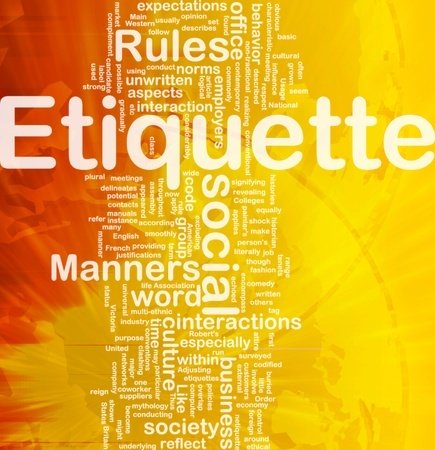Common Sense Etiquette is the Practical Foundation of Good Manners
 Image Source: ivankoivanko; "Group of friends taking a selfie with smartphone.", 2025. Accessed via https://www.123RF.com/photo_69069084, Standard License.
Image Source: ivankoivanko; "Group of friends taking a selfie with smartphone.", 2025. Accessed via https://www.123RF.com/photo_69069084, Standard License.The term "common sense etiquette" stands as a beacon of practical wisdom in our world of complex social interactions. We often hear the phrase "it's just common sense" when discussing proper behavior, but what exactly does this mean, and how do we develop this essential social skill?
What Is Common Sense Etiquette?
Common sense etiquette is the practical application of situational awareness and empathy to social interactions. Unlike rigid rules of formality, common sense etiquette adapts to context while maintaining respect for others. As Eleanor Roosevelt suggested in her 1962 "Book of Common Sense Etiquette," the fundamental rules of good behavior should be guided by practical understanding rather than arbitrary traditions.
Common sense etiquette is:
- Contextual – Understanding what's appropriate given the specific situation
- Empathetic – Considering how your actions affect others
- Practical – Focusing on solutions that work rather than strict adherence to convention
- Universal – Crossing cultural boundaries through basic human respect
How Common Sense Develops
Common sense isn't innate—it's acquired through experience and observation. People develop common sense etiquette through:
- Observational learning: Watching how others successfully navigate social situations
- Experience: Learning from personal mistakes and successes
- Feedback: Receiving input about our behavior from others
- Cultural immersion: Absorbing the unwritten social norms of our communities
Children who grow up seeing adults practice mindful consideration of others naturally incorporate these behaviors into their own repertoire. This observation-based learning creates a foundation of practical intelligence that serves them throughout life.
The Practical Elements of Common Sense Etiquette
Situational Awareness
At the heart of common sense etiquette is situational awareness—the ability to "read the room" and adjust behavior accordingly. This means understanding:
- The formality level of an event
- Cultural expectations in different settings
- The emotional state of those around you
- Power dynamics at play in social or professional interactions
Someone with strong situational awareness knows when humor is appropriate and when seriousness is required. They can sense when to speak up and when to listen, making others feel comfortable in their presence.
Respectful Communication
Common sense dictates that communication should be clear, honest, and respectful. This includes:
- Speaking at an appropriate volume
- Making eye contact
- Listening actively without interrupting
- Expressing disagreement respectfully
- Acknowledging others' perspectives
These communication practices demonstrate respect for others while facilitating meaningful exchange—the foundation of social harmony.
Consideration for Others' Time and Space
Common sense etiquette recognizes that respecting others' time and personal space is fundamental. This includes:
- Being punctual for appointments
- Not overstaying your welcome
- Respecting physical boundaries
- Responding to communications in a timely manner
- Being prepared for meetings and events
These considerations show respect for others' autonomy and demonstrate that you value their time as much as your own.
Digital Common Sense Etiquette
As our interactions increasingly take place online, common sense etiquette has expanded to include digital spaces:
- Not typing in all caps (which resembles shouting)
- Respecting privacy by not sharing others' information without permission
- Being mindful of response times to messages
- Considering how your posts might affect others
- Using appropriate language for the platform
The principles remain the same—respect, awareness, and consideration—applied to new contexts.
Why Common Sense Etiquette Matters
In an increasingly divided world, common sense etiquette serves as a bridge between different perspectives. It allows people to:
- Build stronger relationships based on mutual respect
- Navigate unfamiliar social situations with confidence
- Avoid unnecessary conflict
- Create inclusive environments where everyone feels valued
- Accomplish goals more effectively through cooperation
As Eleanor Roosevelt understood, etiquette isn't about rigid rules but about creating harmony through practical wisdom and respect.
Developing Better Common Sense Etiquette
To strengthen your common sense approach to etiquette:
- Practice mindfulness in social situations, paying attention to others' reactions
- Ask questions when unsure about expectations
- Reflect on interactions afterward to identify what worked well
- Seek feedback from trusted friends or mentors
- Read broadly about different cultures and perspectives
Remember that common sense etiquette is a lifelong learning process. Even the most socially adept individuals continue to refine their understanding of appropriate behavior across diverse contexts.
Common sense etiquette represents the practical intelligence that guides harmonious human interaction. It's not about memorizing rules but developing awareness, respect, and adaptability. By paying attention to context, learning from observation, and prioritizing others' comfort and dignity, we cultivate the common sense that informs truly good manners.
As Eleanor Roosevelt wisely recognized, etiquette works best when informed by practical wisdom rather than rigid tradition. In developing common sense etiquette, we create not just polite interactions but meaningful connections that enrich our social fabric.














